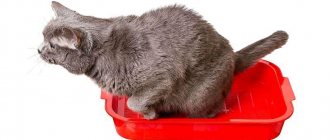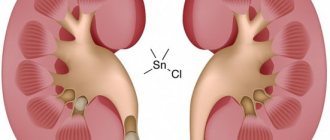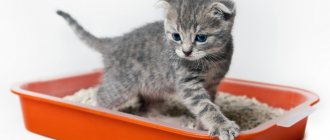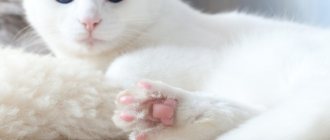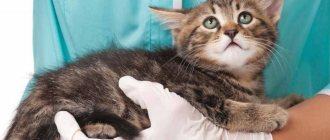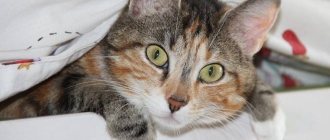How often should a cat poop?
A cat is an amazing animal.
If you want to have one, you need to learn everything about their body. It is very important to know how often cats poop, because this significantly affects their health and full life. The digestive system and its coordinated and proper functioning are very important in the normal functioning of the cat’s entire body. Simply put, how a kitten will feel depends on how many times it goes to the toilet.
Toilet for newborn kittens
In the first two to three weeks of life, the cat fully cares for its offspring and helps them go to the toilet.
By licking newborn babies, a caring mother cleanses the fur from pathogenic microorganisms, foreign odors, dirt, and stimulates digestive processes. This “massage” allows you to get rid of foreign gases in the intestines, promotes natural emptying, and cleanses the body of harmful decay products. The cat licks all the secretions. A newborn kitten should go to the toilet 7-10 times a day. Digestion is a complex physiological process aimed at releasing energy, which is necessary for normal well-being, vital activity, and the functioning of internal organs and systems. In the gastrointestinal tract of animals, complex compounds are converted into simple ones, accessible for absorption, which subsequently take part in metabolic processes - metabolism. The body is saturated with useful nutrients - vitamins, macro-microelements.
Norms
There are established general standards that indicate the normal state of health of a pet.:
- at the age of up to three weeks, the mother helps the newborn with this; she simply licks all their secretions, so it is impossible to indicate the exact number of times. With her rough tongue, she activates the digestive system, which is not yet fully adjusted;
- A kitten at three weeks can already go to the toilet on its own, and this should be from three to six times a day. His stomach and all other parts of the digestive system are slowly starting to work;
- at the age of 2-3 months, the cat visits the litter box 3-4 times. At this age, it is recommended to transfer the kitten to a nutritious diet, monitor the consistency of feces and their color;
- six-month-old kittens are already considered adults, such a cat should walk around 2-3 times a day;
- adults – 1-2 times every 24 hours;
- Once they reach 8 years of age, all cats are considered old. Their physiological processes are not carried out to their full potential and are slowly malfunctioning. A pet can get good results if it goes to the toilet once every two days.
On average, a cat should poop once a day. This will have a positive effect on her health, feces will not stagnate in the large intestine and rectum, heaviness and bloating will not be felt, and as a result - normal functioning of the digestive system and the pet’s well-being.
The amount of feces should be up to 100 grams, but the cat should pee from 20 to 500 ml per day.
Of course, it all depends on the age of the cat, on his diet, and on his state of health. If the pet eats dry food, then cats should poop once every 2-3 days. The stool of tailed and furry pets completely depends on their diet.
If the owner thinks that his pet doesn’t go to the toilet a lot, then you can add boiled and grated beets, a little olive or vegetable oil to the diet. Sometimes, it is worth looking for feces not only in the tray, but in any place in the apartment or house.
Methods of struggle and methods of punishment
The cat often goes to the toilet a little at a time
It is impossible to leave the situation as it is. The animal will continue to shit in the wrong places, but if the cat shits in the wrong litter box, you shouldn’t yell at it. There are certain ways to easily wean your pet from this.
It is recommended that the moment the animal wants to defecate, pick it up and carry it to the tray. As soon as the pet does what the owner wants from it, it is worth treating the cat with a treat to consolidate the positive result. This should be done every time until the pet gets used to the tray.
You cannot punish an animal or poke its nose into its marks. Because of this, the pet may decide that it is doing the right thing, or it may start defecating in various places in the apartment out of spite. It is recommended to show him who is boss.
The following method may seem funny and ridiculous, but it is better to adopt it, as it will help solve the problem. We need help deciding on the right place to defecate. It is necessary to show the animal who is more important in the house. To do this, you should catch the cat at the moment when he is about to defecate, take him by the scruff of the neck, look into his eyes and hiss. At the same time, you can lightly hit him on the nose with your finger.
Don't yell at your pet if he misbehaves
Note! You cannot stop training until the pet looks down, as this will indicate defeat. At the same time, it is recommended to start using folk remedies that will scare the cat away from his favorite corners.
How to tell when your cat wants to go to the toilet
Many owners, especially as soon as they accustom their kittens to the litter box, are afraid that their pet will do everything correctly and in the designated place. If a kitten scratches any surface with its paws, it shows you that it wants to poop - quickly take it to the litter box.
In order to relieve themselves, cats carefully choose a place, while sniffing everything around. If you notice this behavior in your pet, go to the toilet immediately.
Eyes that froze, thought and glazed also indicate a quick visit to the tray.
Over time, of course, the pet will get used to it and understand where it needs to go and where to relieve itself, but initially it needs to be shown to it several times.
In order for your cat to go to the toilet normally, you need to do the following::
- provide him with the correct diet. The cat should eat: vegetables, fish, meat, cereals, dairy products, food with sufficient fiber content;
- if you feed your pet with special food, it must be of high quality;
- drinking plenty of water;
- the tray is always clean - the cat does not go to the toilet a second time in dirty sand;
- protect your cat from constipation and always monitor his health.
Why does he refuse to pee and shit in the litter tray?
A pet's litter box is practically a sacred place. If your cat starts pooping anywhere, the first thing to do is check its litter box. An animal may stop defecating for a number of reasons.
Place
The dog doesn’t poop: what to do if it hasn’t gone to the toilet for a day
Pooping cats do not like attention to themselves during defecation. For such an intimate process, they like to choose a more secluded space, hidden from prying eyes.
Note! Some animals require a closed tray, made in the form of a house.
The tray next to the washing machine is not the best place
Wrong tray
The place for defecation itself may not make the cat want to shit there, as this is connected with the instincts of the animal. Previously, the cat family developed the habit of burying feces in order to hide the smell from enemies or to sneak up on the victim unnoticed. Now there is no need for this, but the habit remains, and therefore you should not deprive your pet of filler in the tray, replacing it with a mesh. The animal may not like this, which is why you will have to watch the cat shitting in the wrong litter box.
The animal does not like the smell coming from the litter box
If your cat doesn't poop in the litter box, it may be due to a bad smell coming from the litter box. Cats love cleanliness, and therefore it is necessary to change the litter on time and clean the room itself, since even garbage lying nearby can confuse the pet.
The animal may not like the selected filler. You should not buy options with a strong smell, as it can scare away your pet. Depending on the cat’s preferences, by trying out different types, over time it will be possible to choose the appropriate filler.
Note! Not only the smell of filling the tray can confuse the cat, but also other strong aromas emanating from it. Avoid cleaning your cat's litter box with strong-smelling detergents. Cheap plastic, which the container itself may be made from, can also emit an unpleasant odor.
Preventing constipation in cats
This is a difficult but exciting topic about the prevention of constipation in cats.
Here I will briefly outline what I managed to find out on this issue. An adult cat should go to the toilet “in a big way” about once every 24 hours. When feeding natural food, there is less waste and the cat goes to the litter box less often - several times a week, and the correct excrement will be light in color and crumbly. Cats can be mildly constipated. Sometimes constipation can occur with more frequent bowel movements, but hard feces cause discomfort for cats. According to American veterinarian Dr. Lisa Pearson - when feeding dry food, the diameter, smell and amount of excrement are NOT normal, and the digestive system loses its elasticity, so there are often problems with the transition to natural food.
Why does a cat poop blood?
If the owner regularly cleans the litter box, then without much difficulty and in time he will notice that his cat goes to the toilet with blood. Sometimes other impurities are found in stool that should not be there. For example, mucus, hair or helminth particles.
The most common reasons why this happens:
- Poor nutrition. If a cat is fed food from the human table - cereals, bread, or cheap cat food, this leads to digestive dysfunction. Your pet may become constipated, especially if there is insufficient drinking water. Dry feces damage the intestinal walls, so when your cat poops, blood appears in his stool.
- The pet eats bones. Cats should not be given bones, especially tubular ones, they are very hard and cannot be completely digested. Small sharp pieces injure the intestinal mucosa. As a result, the cat goes to the toilet with a lot of blood.
- A pet has swallowed a foreign body - a wood chip, a fragment of a toothpick, a small piece of plastic. Any small objects with sharp edges that injure the intestinal walls are dangerous.
- Food allergies. When an allergen enters the digestive tract, the body immediately reacts to it. An inflammatory process occurs in the intestines, which leads to disruption of the integrity of the mucous membrane. For this reason, a small amount of blood appears in the stool.
- Blockage of the intestines by hair. This problem is common in long-haired cats. When they lick, they swallow their hairs. Whole lumps accumulate in the stomach. The movement of food becomes difficult, and the pet becomes constipated. It becomes difficult for the cat to poop because the hardened feces are difficult to pass out and damage the rectum.
- Worms. Some types of helminths attach to the intestinal walls. They damage the mucous membrane, so the cat may poop with blood.
- Poisoning by poison. If a cat likes to hunt and goes out for walks, then it cannot be ruled out that she could have eaten a poisoned mouse. Rodent control products cause internal bleeding.
- Colitis. When the colon mucosa becomes inflamed, blood and mucus appear in the stool.
- Tumors. If your cat poops blood, there may be tumors in his digestive tract. They can be benign or malignant. During movement, feces touch the tumor and injure it, so blood is released.
- A side effect from taking certain medications. After treatment with antibiotics, the intestinal microflora is disrupted and dysbiosis develops. This may cause blood to appear in the stool.
- Infectious diseases. Some viruses can cause hemorrhage, but other alarming symptoms should also be present - fever, diarrhea, vomiting, lethargy. If a cat poops loose stool with bloody contents, most likely it is a viral disease. It is important to take him to the veterinary clinic as soon as possible, otherwise he will die from dehydration.
- Often cats poop with blood due to diseases of the internal organs - due to liver problems, stomach ulcers, and pancreatitis.
Little kittens are very curious. During the game, they strive to stick their nose everywhere, so they can get into trouble. Potential dangers for them include small objects on the floor and open packages of detergents or cleaning products.
An angry cat may accidentally knock over the bottle and step its paw into a puddle. Further actions are known - the pet will begin to lick itself and get poisoned.
In most cases, if a cat poops blood, the responsibility lies with the pet owner. It is important to ensure that liquid and bulk disinfectants and laundry detergents are kept out of reach.
What affects going to the toilet?
Before you start getting acquainted with the “norms,” it’s worth talking a little about what affects the number and frequency of visits to the litter box.
Firstly, this is, of course, age. Kittens, adults and older cats go to the toilet with different frequencies. Secondly, the regime and diet. Everything is simple here, for example, the more often your pet drinks, the more often he will visit the litter box. In addition, each cat, like a person, has its own habits and rhythm of life, so it is not surprising that one pet has to be cleaned 2-3 times a day, while another can be found in the tray only once a day. That is, it is necessary to make allowances for the characteristics of a particular animal and its body.
Objects of assassination attempts: carpet, bed and sofa
You should not start getting angry and scolding the animal before finding out the reason for its defecation in the wrong places. But even after this, you should be patient and try to wean your pet from a bad habit.
Important! It's hard to stay calm when your cat poops on your bed, sofa, or favorite rug, but it's necessary because negative reactions can make the situation worse.
Bed and sofa
You should not believe in signs that say that marks in the bed will bring wealth and other benefits. Often this only brings trouble in the form of damaged bedding, since the smell of cat urine is very difficult to remove and many sets have to be simply thrown away.
It’s one thing if your pet can’t get into the litter box, and so he relieves himself next to it. But if he purposefully goes to pee in the master’s bed, you should try hard to wean him from this.
To correct the situation, it is recommended to act quickly - you will have to monitor the animal. If the cat intends to mark the bed, you should spray it with a spray bottle. Despite the fact that the cat is considered a clean animal, it does not like water, and therefore will quickly learn its lesson.
Cat repellent spray
Carpet
Urine odors are also difficult to remove from carpets, so you need to act quickly. It is necessary not only to wash the item with a disinfectant as soon as possible, but also to treat it with a solution of water and citrus essential oil. Strong smells will scare away the cat and he will subsequently refuse to defecate in this place.
Note! You should not use a concentrated solution for these purposes, since the aroma will dissipate for quite a long time, but will have time to cause a lot of headaches for the owners of the premises.
How many times do kittens go to the toilet?
Very young kittens (up to 3-4 weeks) feed exclusively on mother's milk. Their digestive system is not yet very developed, so there is no need to talk about any regularity.
Starting from the age of one month, kittens learn to drink milk from a saucer and gradually become interested in other foods, including solids. In addition, at this age their digestion is improving, so, although irregularly, they need to go to the toilet. On average, up to three months, a kitten can go to the toilet from 1 to 3 times a day, both “big” and “small”
Starting from 3 months of age, the process of going to the toilet should gradually normalize and become regular. The acceptable maximum can be considered 3 “piles” and 6 “puddles”. The high activity of the kitten has a big influence here, because at this age he constantly plays and runs around a lot, which is why he drinks a lot.
Why do problems with stool occur?
If an older kitten with well-opened eyes eats and drinks well, but cannot walk around every day, then there are the following reasons for this:
- Stress. Very often, a kitten suffers from constipation due to stress. Early weaning from a cat has a particularly difficult effect. The kitten, missing its mother cat, sometimes experiences difficulty passing stool for 5 days. If kids in a new home cannot go to the toilet on their own during this time, then there is nothing wrong with that. If the situation does not resolve after 5 days, then you need to visit a veterinarian. You need to try to make the cat calm down; as soon as he gets used to his new place of residence, the situation should resolve itself.
- A kitten may have difficulty passing stool if it has an improperly balanced diet. When a cat finds itself in a new home, you should try to initially stick to the same menu as the old owners. It is best to use specially formulated food for babies. When a cat eats natural food, it is better to include plant foods, boiled meat, and cereals. After the new owners select suitable food for the babies, they themselves begin to go to the toilet. How many times a cat goes to the litter box depends on what it eats. He can go up to 4 times a day if he eats food rich in fiber; when eating meat, cats visit the litter box about 2 times a day.
- Another common cause is constipation. When a kitten cannot poop for about a week, it may have a health problem, which led to the development of a similar situation. In this case, the pet must be shown to a veterinarian; only he can correctly assess the situation and prescribe treatment.
Adults
A cat can be considered relatively mature from the age of 6 months. By this point, internal processes in their bodies usually normalize, and pets also develop their own habits. However, trips to the toilet can still be quite frequent - up to 3 and 5 times, respectively.
The cycle is finally established after a year. It is then that you can clearly trace the number and frequency of visits to the tray, and also notice that they often coincide in time.
Adult cats with a moderate diet go to the toilet “largely” 1-2 times a day.
As for the functioning of the urinary system, everything is somewhat more complicated: it is structured differently in males and females. So, the urinary ducts of cats are much thinner and more tortuous, so they are unable to completely empty their bladder, which, in turn, leads to more frequent sitting in the litter box - up to 4 times a day. Neutered cats go to the toilet even more often, and even 6 trips in 24 hours is considered the norm in their case.
Cats usually go to the litter box 1-2 times a day, but during pregnancy these numbers may be slightly higher.
In rare cases, castrated cats and sterilized cats, characterized by low mobility and laziness, can go to the toilet even once a day without experiencing any problems.
As for quantitative indicators, in a healthy adult animal, on average, the amount of excrement per day can reach 100 grams, and urine - up to 500 milliliters.
Opinions, advice and special remedies
A rather cruel but effective remedy is to lock the animal in the same room with a tray for several days. In this case, you need to show love and care for the pet, but not release the cat into the wild. At the moments when he goes into the tray, you should reward him with a treat, but at the same time maintain the same position to consolidate the result.
You can train an animal to use human amenities in the form of a toilet. Cases have been recorded of cats flushing themselves after defecation. This is not achieved in one day, so you will have to be patient and gradually accustom the animal to the process:
- If the tray is not initially located in the toilet, then it is worth moving it to this room and accustoming the cat to it.
- Gradually it is worth starting to increase the height of the tray. To this end, you need to start placing newspapers or magazines under it. It is necessary to stop the process at the moment when the tray is at the level of the toilet.
- After the cat is completely accustomed to the new height, the tray should be placed on the closed toilet lid so that the pet gets used to the new location of the tray.
- After some time, you will have to install a children's seat on the toilet, place a flat tray on top of it and pour a small amount of filler into it so that the animal understands what they want from it.
- The dish can be removed at the moment when the cat understands what is required of him.
Important! The door to the room should always be open so that the pet does not have problems with access. If possible, it is recommended to make a special entrance in the door for the cat.
A cat can be toilet trained, but it takes a lot of time
You shouldn’t scold an animal if it decides to poop in something other than the litter tray. There may be a number of reasons for this, which are worth finding out first. Perhaps the reason for leprosy is the wrong upbringing received from the owner. You should be careful when training your animal to the right place to relieve itself.
How often does a cat go to the toilet: urination
Normally, the animal’s body should produce from 50 ml to 200 ml of urine, depending on the age of the pet.
The owner needs to know how often the cat should go to the toilet
Kittens have a small bladder capacity; they need to empty it up to 10 times a day, which is the norm. As the animal grows up, it needs the tray less and visits it 4-5 times a day.
Cats need to go to the toilet more often than cats, which is due to their physiology. With proper nutrition, cats pee up to 5 times a day, regardless of whether they are neutered or not. Cats urinate 3-4 times.
When urination becomes too frequent, a medical condition is not always present. Frequent visits to the litter box will be the norm for cats during pregnancy, as well as in the heat, when the animal drinks a large volume of water. In other cases, if you urinate too frequently, you should immediately contact a veterinarian.
Important! When an animal visits the litter box less than 2 times a day, it definitely needs veterinary care, since the condition indicates the development of pathology.
Why does a cat shit in the wrong place: reasons
Before you try to understand what to do if your cat goes to the toilet anywhere, you need to decide on the reasons for this action. We will not be talking about kittens that can simply be potty trained, since in this case the behavior is understandable. Also, you should not affect old animals, since their trips to the toilet simply need to be monitored, since they forget where to relieve themselves.
Any cat can be litter trained from childhood
Sexual hunting
Estrus can become a reason for leaving marks in various inappropriate places. Not only cats do this, but cats too. The problem of a cat shitting anywhere is often solved by sterilizing it. Moreover, this method works with animals of both sexes.
For your information! This procedure not only allows you to wean your pet from mischief, but also solves many health problems.
Diseases
There are few ways for a pet to show health problems. Ignoring the litter box may indicate the presence of serious diseases that cause pain when urinating. Because of this, the cat begins to associate the standard place for defecation with unpleasant sensations, and therefore the animals pee in others.
Reflexes
A pet could shit in the wrong place not only because of a bad character or illness. Sometimes the cause is reflexive behavior. The animal may have done this because the item smells the same as the toilet. This does not become a habit, the pet simply cannot restrain its desires.
Resentment
Cats are capricious and wayward creatures, and therefore they do not hide their resentment towards humans. They know how to take revenge, they do it in a logical way - they start writing and shitting in inappropriate places.
Important! You need to try to understand why this began to happen in order to subsequently appease your pet.
Fear
Often the problem arises when the pet is afraid to go to its own toilet. This may be due to loud sounds: the washing machine started working or the hair dryer turned on in this room at the moment the cat defecated.
How often should an adult cat go to the toilet?
Growing up, cats visit the toilet much less often: for adults, it is enough to empty their intestines once a day.
In some animals, defecation occurs once every 48 hours, and no pathologies are observed. This phenomenon is their feature, which does not harm health. Danger for the pet arises if feces are not excreted for more than 4 days.
The frequency of bowel movements depends on the age of the pet
Some cats sometimes leave small piles in different places out of revenge on their owner. There are many reasons for this behavior - from a change in the usual diet to a rude attitude. Incorrect behavior is eliminated not by treatment, but by establishing mutual understanding with your cat.
A diet with an excess of protein or fiber, as well as stressful situations, can affect the functioning of your pet’s intestines. In this case, we usually do not talk about pathology - the cat needs to be provided with a balanced diet or eliminate stress.
Preventive actions
The appearance of bloody inclusions in your pet’s stool can be prevented by following these recommendations:
- feed the cat high-quality food, do not give it prohibited foods and treats;
- do not leave small objects on the floor that the cat could swallow;
- worm your pet regularly;
- adhere to the routine vaccination schedule;
- ensure that the cat has constant access to clean drinking water;
- Brush the coat 2 times a week;
- do not let the animal go for a walk unattended;
- Store powder and disinfectants out of reach;
- For any alarming symptoms, seek veterinary help.
There are many reasons why cats poop blood – from dysbacteriosis and allergies to oncology. In any case, do not put off visiting the veterinarian. After all, timely diagnosis of diseases is the key to successful treatment.
Elderly cats
Elderly individuals are less mobile, consume less food, which can cause digestive disorders. As a result, the norm is considered to be the appearance of feces in the tray once every two days.
The stool may have a soft or hard consistency. Their color is possible both light and dark. If an older pet feels fine and does not constantly scream due to pain or when going to the toilet, then there is no need to consult a veterinarian.
What should owners be wary of?
Since small kittens, adult cats, and cats like to relieve themselves in secluded places, it is not always possible to track how many times a day the pet visited its litter box or went to the toilet. Therefore, from the first days of the animal’s appearance in your home, after the completion of the adaptation period, as soon as the cat begins to trust you and gets used to the new environment, carefully monitor its behavior, habits, and general physiological state.
READ What aquarium plants suffer from
If kittens poop frequently, the stool is loose, has a specific sharp unpleasant odor, and foreign impurities are noticeable, contact your veterinarian for help.
The following symptoms should alert owners of furry pets:
- decreased overall activity;
- inadequate response to external stimuli;
- uncontrollable behavior of a pet;
- deterioration of coat;
- rare visits to the tray;
- enlarged, large, tight tummy;
- nausea, vomiting, diarrhea;
- decreased appetite;
- increase in body temperature.
Feces that are too thick, brownish-green, dark or, conversely, too light in color may indicate disturbances in the functioning of the gastrointestinal tract. The problem requires an immediate solution to avoid serious consequences.
Diarrhea in a cat, causes
Diarrhea in cats develops quite often . A one-time loose stool should not frighten the owner, since it is usually a failure that occurs due to minor reasons that do not require a visit to a specialist.
Diarrhea in cats develops quite often
Diarrhea for 2 days or more requires therapy.
There are several main causes of diarrhea in cats:
- Feed intolerance. The animal’s body may not accept the food offered, even when it is of high quality. Most often, the phenomenon is observed when giving low-grade ready-made feed and milk. The problem can be solved by adjusting the diet.
- Sudden change in diet. The cat's intestines and stomach must gradually adapt to the new diet. If it is changed abruptly, diarrhea will easily occur due to irritation of the mucous membrane.
- Worm infestation. The toxins released by worms lead to poisoning, causing loose stools.
- Metabolic disease. This affects most processes in the animal's body, including the number of bowel movements and the density of feces.
- Bowel disease. Diarrhea most often develops with infectious lesions, but may also indicate tumor neoplasms and various ulcerative pathologies. A blood test will be required for diagnosis.
A veterinarian can determine the exact cause of diarrhea in a cat after an examination.
Factors causing dry stool
The cause of dry feces in a cat is that hairballs enter the stomach, which causes the feces to harden. In these cases, veterinarians often recommend giving cats special tablets or pastes that normalize digestion and improve the structure of stool.
In addition, dry feces can be caused by other factors.:
- the presence of congenital pathological processes;
- hernia in the perineum;
- inflammatory process of the rectum;
- diseases in the large intestine;
- tumors of the digestive system;
- cyst.
Sometimes dry feces occur due to severe stress or diseases of the limbs. It is quite difficult for a cat to take a comfortable position, as a result he has problems with bowel movements or produces very dry feces.
© shutterstock
But often dry stool in a kitten occurs due to poor nutrition or ingestion of a foreign body. In these situations, it is necessary to contact a veterinarian, because a specialist will be able to determine why the pet has problems with stool.
Causes of constipation
Constipation in cats develops somewhat less frequently than diarrhea.
The following reasons can provoke this phenomenon:
- incorrect feeding system with excess protein;
- dehydration, when stool becomes too hard and cannot pass out of the intestines;
- lack of movement leading to digestive disorders;
- intestinal obstruction (constipation is not the only symptom);
- the presence of hair in the intestines;
- severe stress (leads to constipation and diarrhea equally);
- hernias;
- tumors of a malignant or benign nature.
Giving an animal a laxative until the cause of the disorder is determined is unacceptable. The veterinarian will determine how to properly solve the problem.
